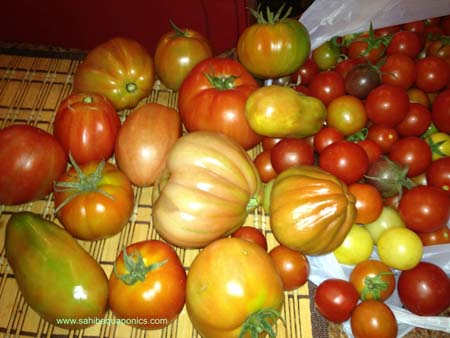
Project News
Sahib Aquaponics: What shall we grow today?
Tomatoes – actually to be more precise – Heirloom Tomatoes
Let me tell you that I am just crazy about eating tomatoes – I mean real good quality tomatoes that actually have taste and flavor. I cannot usually find these in most supermarkets and if I do, they are quite pricey but still leave something lacking in flavor and taste, usually because they have been picked before they have had a chance to ripen and usually have sat in storage and coolers, probably shipped in from some far away place. There really is nothing better than local grown and vine ripened heirloom tomatoes so they have had time for the full flavor to develop. Growing tomatoes in Aquaponics is easy and ever one who has an Aquaponics System can certainly enjoy them fresh. However, to increase the taste and flavor of tomatoes grown in Aquaponics, I have concluded the following during my research over the last three years or so.
First and foremost, try to only grow “Heirloom” tomatoes. So what is “Heirloom”? Seeds of plants that have passed down by families over the years (usually over 50 years), and those that have preserved the unique taste, flavor and character are usually referred to as “Heirloom”, sometimes also called “open pollinated” or “Heritage” (in UK). The fruits may not all look uniform and be of different size and shapes. To those who are interested in actually tasting their food, these are sought after and command a higher market price. As awareness is growing of the associated additional health benefits of eating such food, their demand is on the rise. You as a grower can certainly benefit from this “Niche” section of the food market. Yes it will take time and patience to locate the consumers who will appreciate your unique “heirloom” produce grown locally and naturally. Let me assure you that once they have tasted the produce, they will not be going elsewhere and will become loyal customers so long as you continue to grow such wonderful tomatoes.
[column size=”1-3″ last=”0″ style=”0″]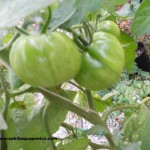 [/column][column size=”1-3″ last=”0″ style=”0″]
[/column][column size=”1-3″ last=”0″ style=”0″]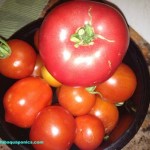 [/column][column size=”1-3″ last=”1″ style=”0″]
[/column][column size=”1-3″ last=”1″ style=”0″]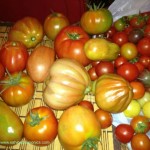 [/column]
[/column]
Growing heirloom tomatoes in Aquaponics to attain the full flavor and taste, I have found that the best results are obtained when I grow them in pots filled with my own “soil mix” and place them either in rafts or recirculating media wicking beds. This allows the tomato plants to always have the effluent rich re-circulating fish water that is high in Nitrogen as well as allow “top-side dressing” by adding very small amounts of natural and organic material such as vermicompost, high phosphorus bat guano, bone meal and rock salts such as Azomite. As there is not “top” watering other that the occasional spray of Vermicompost Tea, there is very little chance of any significant leaks of such into the Aquaponics System water so as to harm the fish. I have found that we have a significant increase in the fruit yield of each tomato plant as well as enhanced taste and flavor. Yes there is one major disadvantage than growing regular tomatoes. These heirloom tomatoes require very careful handling. Many of them have thin skins and a short shelf life once picked. They are thus ideally suited to the small urban farmer serving the local customer – that would be you.
“Is it profitable?”
So what is the average selling price of a pound of Heirloom Tomatoes? I “goggled” this and came across a range from $1.00 to a high of $5.50, the average being $3.50. I was recently informed of a nearby Hydroponic grower getting $7.50 per lb! Well it is early in the tomato season. You can command a higher price at either end of the season as other local growers may not have the produce available for market – here a controlled environment such as a greenhouse /hoop house will certainly make economic sense. Growing them in Aquaponics can help you command 50c to $1.00 lb more especially if you can allow
”u-pick” as well as “mix & match” the varieties. The yield per plant varies depending upon the heirloom tomato plant variety and growing environment. In independent studies the range that has been seen is a low of 9lbs to a high of 19lbs. For our example we will use a low yield of only 14lbs per plant. You should space your heirloom tomato plants at least 15 to 18 inches apart if using a staggered raft formation and vertical trellising – ideally 2 feet if you have the space. If they are to be placed in re-circulating media beds I recommend a minimum of 2 ft distance in each direction and vertical trellising. You will have to keep ahead of the heavy leaf growth and may occasionally have to prune (be careful not to over do this), and ensure proper support of the vertical trellising. I try to mix and match the heirloom tomato varieties as some plants are more prolific than others. I must confess I also enjoy seeing the different colors of the various heirloom tomatoes. You also need to ensure that there is plenty of air circulation.
If you had a fifty foot long by 4 foot wide grow bed area (raft or media), so 200 sq. ft. space, and the heirloom plants were spaced at 2ft staggered, you should be able to plant at least 50 plants per growing season. Assuming that we receive an average of 14lbs heirloom tomatoes per plant and just the average price of $3.50 per lb, each growing season should provide you with a gross return of around $2,500. Now if you have a controlled growing environment, you may be able to command much higher prices at the start and out of the normal growing season. Here in Central Florida we experience at least two growing seasons, so could earn around $5,000 from the 200 sq foot of growing area allocated to heirloom tomatoes. In a controlled growing environment you may be able to stagger the planting so as to have virtually continuous growing thus substantially increase your revenue form the sale of heirloom tomatoes. Remember that you should grow multi crops to the niche market that you identify for your area and climate so as to maximize your revenues. There are other products you can grow in Aquaponics other than leafy greens and still make a profit – remember Okra, Eggplant, Hot Peppers, culinary herbs and so on.
[column size=”1-3″ last=”0″ style=”0″]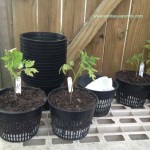 [/column][column size=”1-3″ last=”0″ style=”0″][/column][column size=”1-3″ last=”1″ style=”0″]
[/column][column size=”1-3″ last=”0″ style=”0″][/column][column size=”1-3″ last=”1″ style=”0″]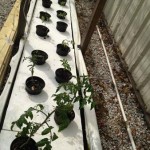 [/column]
[/column]
I have found the following web article on Heirloom Tomatoes to be helpful and am sharing it with you http://www.hobbyfarms.com/crops-and-gardening/heirloom-tomatoes-growing-selling.aspx
I will request my daughter to include some Heirloom Tomato recipes on her Blog www.lovelaughmirch.com
As to whether it is “profitable” from a health point of you, this is going to be your decision. Let me help you a little. Growing them by aquaponics means ensures that you are assured the best natural taste. As I was quoted in the recent article in Cornell University Small farm Program Newsletter – the Urban Gardening section “This was a far superior way to grow it locally, grow it naturally, without having to resort to harmful pesticides and fertilizers and such, because if I did, my fish would die.”
http://smallfarms.cornell.edu/2012/04/02/re-circulating-farms-growing-healthy-fresh-food-and-a-new-local-food-culture/
I have listed just some of the health benefits of eating heirloom tomatoes in the following link: http://jenubouka.hubpages.com/hub/Heirloom-Tomato-Beginners-Guide
In future “What shall we grow today?” article’s I will write about some of the vegetables and culinary herbs that you can grow in Aquaponics. Please let me know if there are any vegetables you would like to grow in Aquaponics and know more about them.
God bless
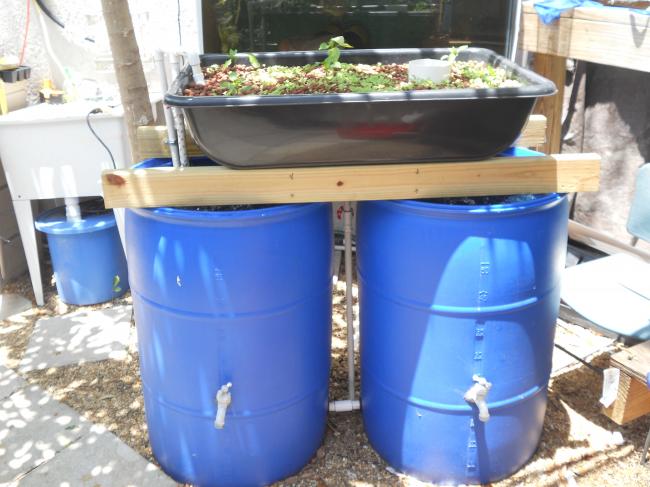
Project News
Sahib introduces an Aquavermiponics System
Sahib introduces an AquaVermiponics system in order to have a quality supply of ‘casting tea”, also known as “compost tea” always available for foliar spray for his Aquaponically grown plants and produce. So what is Aquavermiponics?
Aquavermiponics is the combination of Aquaculture, Hydroponics and Vermicomposting. How Vermicomposting is added to Aquaponics can vary to some extent as to the need for the particular application. Why add Vermicomposting to the better than organic method of growing food using Aquaponics? To answer this one has to know a little about both Aquaponics as well as Vermicomposting. In Aquaponics, there can be no harmful pesticides or chemical fertilizers added to the system. Even products that are approved for use in organic gardening can result in disastrous consequences if added to an Aquaponics system. Take Neem Oil as an example.
Being from Indian Ancestry, naturally I am familiar with the many beneficial qualities that Neem Oil offers such as being a natural insect repellent and a safe pesticide that is organically approved. It has been found to be effective in controlling such pests as white flies, aphids, scales, mealy bugs, spider mites, locusts, thrips, and Japanese beetles. Neem Oil is also biodegradable, breaking down quickly and it is also considered to be non-toxic to mammals, birds, bees or earthworms. Neem Oil is certainly a wonderful product in organic gardening if used correctly.
Severe caution: Do Not Use Neem Oil in Aquaponics! Foliar spraying Neem Oil, while helping you control the pests mentioned above could result in the death of all your fish. Why risk such?
So I was looking for an alternative foliar spray product that would not only help in controlling the pest issues but also help in providing additional nutrients and trace elements to the plants growing in our Aquaponics systems. We have been spraying Maxicorp with iron on occasions as well as Vermicompost tea with excellent results. We do not always add the worm castings directly to our media beds (we may if they are wicking beds), but prefer to use foliar spray. Why? We had read and do believe that plants absorb the beneficial aspects far quicker as a result of foliar spraying. As every sustainable urban farmer knows, Vermicompost is a wonder product in the world of agriculture. It use is increasing rapidly as the numerous benefits are being shared with each other. Here is some information as well as the source:
Castings contain: 5 times the available nitrogen, 7 times the available potash and 1 1/2 times more calcium than that found in 15 cm of good top soil. Therefore, castings are supplied with available nutrients. The nutrients are also water soluble and immediately available to plant life. You will find that most potting soils have nutrient life of 2-5 days, where worm castings will last up to 6 times as long as other types of potting soils. You will need 5 times as much potting soil to do the same job as the worm castings. So, in the long run, worm castings are much cheaper and do a much better job. Also, castings hold 2-3 times their weight in water. That means you water less and the pot will stay damper for a longer period. Worm castings will not burn your plants; unlike using any fresh raw manures (cow, horse, etc.) which can burn root systems if it is not applied properly. The advantage of using castings is the manure passes through the worms' digestive system producing rich organic plant food and a slow releasing fertilizer that allows for better growth. Kids for Landcare: Wormwatch, Education Department of South Australia, 1992, p. 35.
A worm casting (also known as worm cast or vermicast) is a biologically active mound containing thousands of bacteria, enzymes, and remnants of plant materials and animal manures that were not digested by the earthworm. The composting process continues after a worm casting has been deposited. In fact, the bacterial population of a cast is much greater than the bacterial population of either ingested soil, or the earthworm's gut. An important component of this dark mass if humus. Humus is a complicated material formed during the breakdown of organic matter. One of its components, humic acid, provides many binding sites for plant nutrients, such as calcium, iron, potassium, sulfur and phosphorus. These nutrients are stored in the humic acid molecule in a form readily available to plants, and are released when the plants require them. Mary Appelhof, Worms Eat My Garbage, 1982, p.68.
Worm Castings also contain trace minerals, such as small amounts of Phosphorus and Potassium, Iron, Calcium, Magnesium, Sulfur, Boron, Copper, Zinc and Manganese. There are two ways to obtain the solution, what we call “compost tea”, for the foliar spray. One is to brew the compost tea by merely soaking a bag of worm castings in water for some time and using this spray solution, a weak “compost tea” – the extracted method. The other, and one that I prefer, is known as the “aerobically” method.
In the brewing method, compost/castings are placed into a container of circulated and aerated water (via an air bubbler or similar system) typically with other nutrients. The circulated water extracts the microbiology and the microbes are in an abundance of both oxygen and nutrient to feed upon. In this method, colonies of microbes are brewed in exponential numbers, a colony of bacteria for instance can double in population every 20 minutes. Aerobic brewing takes longer than basic extraction with common brewing times of 12 to 24 hours. Brewing time is very dependent on water temperature with warmer water creating faster brews. Aerobically brewed teas have much higher microbe population densities than extracted teas and for this reason are the tea of choice. The sign of a good aerobically brewed tea is a good head of foam and scum on top signifying healthy microbe action! https://www.yelmworms.com/compost-tea/page3.htm
As we have increased the growing area in our Aquaponics research farm, we require an increased quantity of the aerobically brewed compost tea. This compost tea takes at least a couple of days to make and only has a limited shelf life (try use within 12 hours if possible). We have designed an Aquavermicponics system that will ensure that we will have the aerobically brewed compost tea available on hand at all times. In our system, we can also experiment by adding such wonderful natural products as Molasses, thus adding additional nutrients for excellent and robust natural plant growth. Prior to using such this incredible powerful and magical “Sahib Compost Tea”, one could add just a few drops of “hot sauce” and/or cinnamon juice extract so as to increase the potency of the solution. Do remember that you should only spray when temperatures allow and when not harmful to beneficial insects such as honey bees and lady bugs. Here are a few pictures of our Sahib’s Aquavermiponics system. We have added a media bed with a modified Affnan bell siphon so as to increase aeration.
[nggallery id=9]
SAHIB AQUAPONICS is a Florida, USA domiciled corporation and is a pioneer in developing and building Aquaponics hybrid urban growing systems for sustainable urban gardening. The company specializes in Aquaponics and in the promotion of sustainable urban gardening and the establishment of such Ecosystems. Their mission is to strive to be at the forefront of sustainable urban gardening by adopting the latest Aquaponics technologies and growing methods to provide both high quality food and fish, competitively priced, grown locally and grown naturally. SAHIB AQUAPONICS is providing training workshops for community members and students around the U.S., interested in learning innovative methods and market-based solutions using urban agriculture and Aquaponics.
You are welcome to share your ideas and designs as to how you would suggest we increase additional growing space and/or make improvements. You can submitt them tosahib@sahibaquaponics.com.
God bless
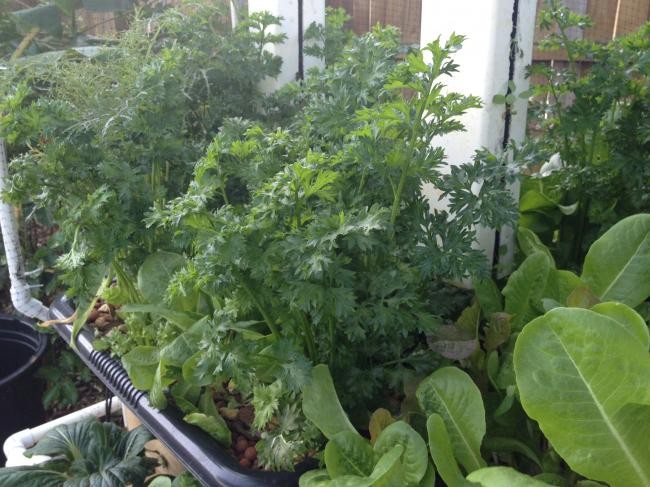
Project News
Sahib Aquaponics Zero Lot Hybrid Aquaponics System was recently highlighted as being “A Good Fit For Small Spaces”. This was an article in Cornell University Small Farm Program Newsletter – the Urban Gardening section.
Here is an extract from the article by Molly Davis…
“A Good Fit for Small Spaces
In suburban Orlando, Florida, farmer Sahib Punjabi has developed several models of miniature re-circulating farms to fit in small, underused spaces, such as storage rooms and patios. In only 18 square feet, Punjabi’s “Zero Lot” Backyard Aquaponic System combines a variety of plant beds with a 55-gallon fish tank.
He aims to build a totally self-sufficient system that can be deployed anywhere, from developing-world villages to U.S. neighborhoods.
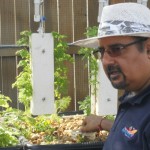


“This was a far superior way to grow it locally, grow it naturally, without having to resort to harmful pesticides and fertilizers and such, because if I did, my fish would die,” said Punjabi. Goldfish require less oxygen than many food fish, but still supply enough fertilizer to nourish lettuces, herbs, and vegetables. Punjabi uses a variety of bedding materials.
“The whole idea is that the plants absorb nutrients from the water so that pure water goes back to the fish tanks,” said Punjabi.
A single 50-watt pump circulates the water through pipes. Valves control the inflow into the beds. Punjabi emphasizes the importance of maintaining the water chemistry, especially the pH and the nitrogen cycle.”
You can read the complete article here:
SAHIB AQUAPONICS is providing training workshops for community members and students around the U.S., interested in learning innovative methods and market-based solutions using urban agriculture and Aquaponics. Sahib will share with you the endless possibilities of how to grow your own food locally and naturally without the use of harmful pesticides and chemical fertilizers by using these Aquaponics hybrid urban growing systems.These Aquaponics hybrid urban growing systems can be scaled to size and can be replicated. They can be modified to be operated off grid as well as expanded as the need arises. Such systems can be used to have fresh food at home, work or anywhere they are set up. They are excellent tools to use as teaching aids so that we can empower the future generation with the knowledge to grow their own food locally by natural means. Sahib’s Aquaponics hybrid urban growing systems can be the basis of feeding the family, the community as well as provide income to the urban farmer. Sahib will also share how such systems can be used in urban retail economy, both by food establishments as well as food/produce retail outlets to enable the consumer to purchase food that has been grown locally and by natural means. Food that is “live” (a new twist on the label “Fresh”), and the type recommended by most medical and health professionals as what we should be eating.
2012 Aquaponics training workshops by Aquaponics Urban Gurus
Next Aquaponics Workshop: June 9th & 10th 2012
These Aquaponics Workshops by Aquaponics Urban Gurus are an excellent place to learn Aquaponics and be empowered to build Aquaponics systems to grow organic food for their family without using harmful pesticides or chemical fertilizers, discover the potential to create another income source as well share such knowledge with many more to help provide sustainable solutions to the world hunger epidemic.
Sahib believes that such training should be affordable so as to enable all sectors of the society to educate and empower themselves in this wonderful way of growing organic food. He also believes in smaller class sizes (not to exceed 20 participants), so that the Workshop training can be personalized as much as possible. By being a participant in such Aquaponics workshops, you will really learn and be empowered to grow your own food locally and naturally.
Space is extremely limited so reserve your space now
Sahib’s Training Workshops by Aquaponics Urban Guru’s
Here is a recent e-mail from one of the Workshop participants…
“Hello Sahib,
I really enjoyed your 2 day Aquaponics class. It was very informative and practical. You made what seemed like complicated gardening into a fun learning experience. Your explanations made it easy to comprehend the principles behind Aquaponics. Seeing your Aquaponics garden and your simple systems setup demonstration, removed all doubts. Even though I am a beginner, I am confident that I can do this now. It opened up a whole new world of providing healthy “organic” food for myself and others. An excellent job done! I will recommend you classes to everyone. Rajaji “
God bless,

Visit & Tour
Sahib Aquaponics Farm Tour Feb 2012

The February Free Farm Tour was the first opportunity for Central Florida members of IDEAS For Us to come and discover the wonderful world of Aquaponics. We certainly had a full house. We had over 60 visitors, 50 of them via IDEAS For Us. We had to arrange 4 tours, starting at 10.00am and lasting well past 4.00pm. A very busy day!
You should have seen the starry glaze in the eyes of all who attended. Was this really true? A sustainable urban food jungle in waste space! We felt so good that we could capture their imagination and open up a whole new world for them to seriously look at the fabulous opportunities that Aquaponics offered re “Intellectual Decisions on Environmental Awareness Solutions”. Everyone who attended left with a big smile on their face and made comments that they would now seriously consider starting their own Aquaponics systems and look at attending the Aquaponics Workshops by Aquaponics Urban Gurus. As announced in January 2012, Sahib Aquaponics and IDEAS For Us have partnered to provide educational tours and professional training programs for students and community members. The first Aquaponics Workshop for the members of IDEAS For Us has been scheduled for March 17th & 18th 2012.
During one of the Free Farm Tours, Sahib was asked whether his offer to donate a Nano or a Micro Hybrid Aquaponics system to any educators who attend the next Aquaponics Workshops by Aquaponics Urban Gurus scheduled for March 10th & March 12th 2012 was still valid. Off Course! We will gladly donate such to any educator, whether they teach elementary, middle or high school students provided they attend the 2 day Aquaponics Workshops.
Why?
Sahib shared with them the following example. He asked them, how do you start bonfire? Both answered that you should start with small twigs that will light easily than the big logs. Small children will learn this wonderful knowledge quickly and will be able to expand its use significantly as they grow. It is for this reason that Sahib stated that he would be happy to donate such systems to the educators to teach our children this wonderful way of life.
[nggallery id=7]
Sahib loves to share his knowledge and encourage everyone to learn. His goal is to empower you to grow food for yourself, your family, your community and your business. Grown locally and grown naturally without any harmful pesticides or chemical fertilizers. He thus offers FREE Farm Tours of Sahib’s Aquaponics Research Farm.
FREE Farm tours are held the first Saturday of every month starting at 10:00am and last for about one hour. As Sahib’s Aquaponics Research Farm is located in a small facility, you will need to register as we try to limit our farm visitors to 12 per tour so as to be able to give you personal attention. Small or large groups are welcome and we encourage field trips for all class sizes. Please plan to have any groups with young children or those with special needs, be chaperoned.
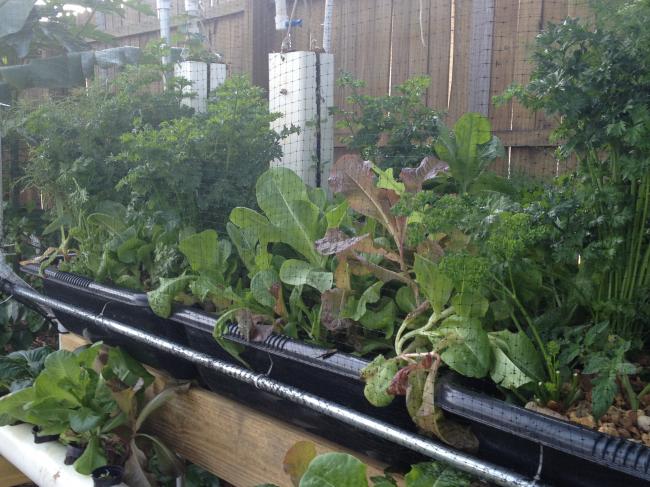
Project News
Aquaponics News
Aquaponics Hybrid Urban Growing Systems introduced by Sahib Aquaponics
Sahib Aquaponics held their inaugural Aquaponics training workshops by Aquaponics Urban Gurus on December 10th, 2011. The Aquaponics Workshops were very well received by all who participated and hopefully the world will have another few people who will build Aquaponics systems themselves, enjoy this way of life and then share such knowledge with many more to help provide sustainable solutions to the world hunger epidemic. Reflecting at the end of the workshop, the question was asked as to what constitutes “success” to Sahib?
Tim Mann of Friendly Aquaponics recently wrote…"To Sahib what the word “success” means is that most (if not ALL) of the participants in the courses go out, build and operate aquaponics systems with the knowledge empowered that Sahib has imparted during the course to help end world hunger". Needless to say, I was very happy to read the following e-mail from one of the Workshop participants…
“Dear Sahib, Just a quick note to again thank you for an interesting and educational two days. We enjoyed it very much and our eyes were opened to a new concept. We are already trying to locate the necessary items to build a system much like the one you demonstrated. Keep up the good work! Best wishes, Clyde and Trudy Edwards”.
The Aquaponics hybrid urban growing system that Sahib demonstrated during the Aquaponics Urban Gurus Workshop was a prototype. Over the course of the next few weeks, Sahib will share with you the endless possibilities of how to grow your own food locally and naturally without the use of harmful pesticides and chemical fertilizers by using these Aquaponics hybrid urban growing systems. These Aquaponics hybrid urban growing systems can be scaled to size and can be replicated. They can be modified to be operated off grid as well as expanded as the need arises. Such systems can be used to have fresh food at home, work or anywhere they are set up. They are excellent tools to use as teaching aids so that we can empower the future generation with the knowledge to grow their own food locally by natural means. Sahib’s Aquaponics hybrid urban growing systems can be the basis of feeding the family, the community as well as provide income to the urban farmer. Sahib will also share how such systems can be used in urban retail economy, both by food establishments as well as food/produce retail outlets to enable the consumer to purchase food that has been grown locally and by natural means. Food that is “live” (a new twist on the label “Fresh”), and the type recommended by most medical and health professionals as what we should be eating.
"The Zero Lot / Backyard Gardener" System
This was the Aquaponics hybrid urban growing system that Sahib shared with the Workshop participants. We introduced two growing methods, one based upon the raft system and the other using media beds. We explained the different medias that could be used as well as explaining them how to mix media to assist in the planting of seedlings. Workshop participants gained hands on experience in the assembly process as well as seeing the complete system operate. They were shown the beauty and functionality of using the bell siphons (we used a modified design based upon Affnan's design), to aid in the aeration process. Workshop participants were requested to assemble a similar Aquaponics hybrid urban growing system and begin to grow food for themselves. Over the course of the next few weeks, we will add vertical towers ("Sahib Sandwich Towers") over the media beds, add an NFT system as well as introduce re-circulating media beds. In due course we will add some containers to be watered on occasions by the fish effluent water. As the fish grow in size or an additional fish tank is added, we will add additional raft beds to dramatically increase the overall growing capacity. The system will be designed to have a canopy to allow shade cloth as well as cover to collect rainwater for recycling. A small solar system will also be introduced so as to be able to operate the complete system off grid. We will post photos as we build and incorporate such additions.
These are the types of systems that Tim Mann was referring to when he wrote… “Sahib is dedicated to “feeding the villages” of the world, are his words for teaching the poorest people in the world how to feed themselves using aquaponics. He is developing Aquaponics systems in Winter Park, Florida, that are the prototypes for affordable systems that will be appropriate for economically disadvantaged and developing nations.” Sahib’s Aquaponics hybrid urban growing systems will be engineered to enable them to be built completely by locally sourced materials as well as complete packages so as to meet different needs and wants. This should ensure that they are affordable systems for the economically disadvantaged, where ever the need is, thus helping provide a sustainable solution to the world hunger epidemic. Water conservation, use of green technology, reducing the carbon footprint while providing a sustainable solution to help develop ecosystems and sustainable living food jungles thus helping reduce, perhaps even eliminate hunger, are just some of the goals and end results of Sahib’s aquaponics hybrid urban growing systems.
Sahib is accomplishing this in the most interesting place ever seen on an Aquaponics farm: in the “dead space” of a suburban strip mall in Winter Park, near Orlando in Central Florida. Recently an experienced Aquaponics gardener commented…” all the improvements that have been occurring at the "Urban Wasteland"… Now it has been transformed into a beautiful and productive "Urban Farmland"!” Tim Mann comments…” This is not only innovative on Sahib’s part, but perhaps prescient also. Although the politicians all say “we’re on the road to recovery”, there are others who talk of going back to basics and being responsible for our own food security. I can’t think of a better use for a lot of those empty strip malls we see nowadays: imagine housing the farming community in the buildings and growing the food in the empty parking lots!”
Sahib is using the profits from Aquaponics training workshops by Aquaponics Urban Gurus to fund the development of aquaponics for the poor hungry world villages. He has set up a separate group for this called “Feed Hunger Now” (see link below). Will you help join Sahib…can we work together in this venture? What ideas do you have to help towards this goal?
http://www.feedhungernow.org/
God bless,
Over the course of the next few weeks, Sahib will share with you the designs and pictures of Sahib’s Aquaponics Hybrid Urban Growing Systems.
The Hobby / Nano System
The Balcony / Patio System
The Zero Lot / Backyard Gardner
The Urban Farmer / Community Gardner

 [/column][column size=”1-3″ last=”0″ style=”0″]
[/column][column size=”1-3″ last=”0″ style=”0″] [/column][column size=”1-3″ last=”1″ style=”0″]
[/column][column size=”1-3″ last=”1″ style=”0″] [/column]
[/column]
 [/column][column size=”1-3″ last=”0″ style=”0″][/column][column size=”1-3″ last=”1″ style=”0″]
[/column][column size=”1-3″ last=”0″ style=”0″][/column][column size=”1-3″ last=”1″ style=”0″] [/column]
[/column]









 Best Western Orlando East Inn & Suites
Best Western Orlando East Inn & Suites Crestwood Suites of Orlando-UCF Area
Crestwood Suites of Orlando-UCF Area Days Inn N Orlando/Casselberry
Days Inn N Orlando/Casselberry Park Plaza Hotel
Park Plaza Hotel Thurston House Bed and Breakfast
Thurston House Bed and Breakfast